How Much Oil To Put In A Lawn Mower
Have you ever wondered just how much oil to put in a lawn mower?
You are not alone.
The other day I got a call from a lawn-mowing contractor and his mowers had both died. He was panicking and wanted to borrow a mower from me.
I have a policy where we won’t loan our equipment so I thought the best way forward was to find out exactly what went wrong.
He told me that the other day he noticed that his two mowers were getting low on oil so he bought a gallon of oil and completely filled both mowers then headed off to work.
By lunchtime, they had both died. Frankly Im not surprised. Just because you can fill your oil reservoir to the top doesn’t mean you should.
I gave him step-by-step instructions (I will tell you about that later) on what to do to get rid of the excess oil and he had his mowers running again in no time.
It’s lucky that he rang me as soon as it happened.
But that little incident got me thinking, how many people know exactly how much oil to put in a lawn mower?
To my surprise, I discovered that different types of mowers can demand quite varied amounts of oil – who knew?
So now, I’m here to shine a light on the mystery for you. In this blog post, we’ll explore the correct quantity and type of oil needed for various lawnmowers and share some tips on maintaining optimal levels.
Key Takeaway
How Much Oil To Put In A Lawn Mower? This depends on the type of mower you have. For a push mower, you will need 10-20 oz a self-propelled one takes 15-18 oz and ride-on mowers take 48-64 oz. Zero-turns take more at around 64-80 oz
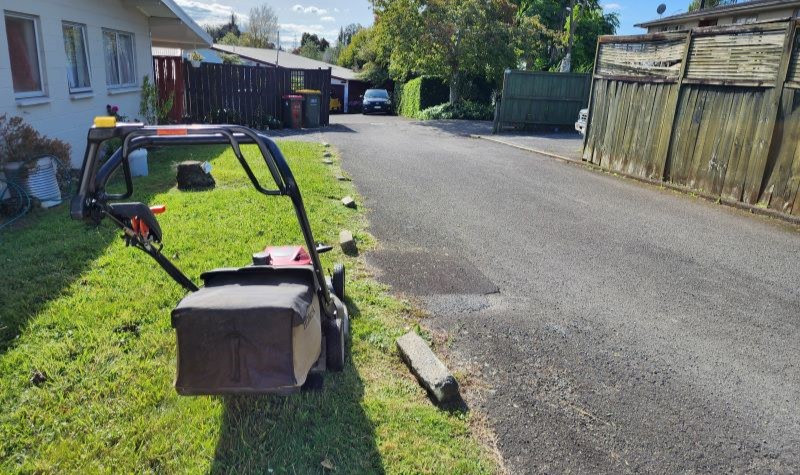
How Much Oil To Put In A Lawn Mower
Different types of lawnmowers have different oil needs.
Push mowers: 10-20 oz of oil
Push mowers need a bit of oil. The right amount is between 10 and 20 ounces. You check this with a dipstick. Too little or too much oil can mess up the engine. So, it’s key to get it right.
For the best results, use clean, fresh oil each time you fill it up.
Another thing that you should note about walk-behind mowers is that they generally do not like being tipped on their side. If you tip it one way you will flood the air filter and if you tip it the other way then you flood the exhaust. This is going to cause a lot of smoke for a short time as it burns off, however, this is unlikely to cause long-term damage to the engine. Please note that this is not the case with two-stroke engines they have the oil mixed in with the fuel so they are fine with being tipped on their side.
I like to track the hours of use with a timer on my push mowers.
Digital Waterproof LCD Hour Meter

Used for 2/4 Stroke Lawn Mower
This hour meter is a gasoline engine hour meter, that only records and shows the total hours accumulated,
Then I change the oil every 75 mower hours. This may sound like if you are mowing lawns commercially but I have found that my small mowers average about 500 hours a year. This is not what manufacturers like Briggs & Stratton will tell you. It is just what I find works best for me and keeps my mowers in good working order.
Self-propelled mowers: 15-18 oz of oil
Self-propelled mowers need less oil than others. They use between 15 to 18 oz of oil. It is a smaller amount but it’s good for their size. This keeps them running smoothly and strong.
It helps avoid damage too. If you are unsure, always look at the owner’s manual for your mower model. The maker knows best about what kind of oil and how much is needed for top performance and longer life!
I am currently using a Rover HRX217 which is a great self-propelled mower. They can be tipped on one side which makes them easier to clean and you need to remember that these kinds of machines often require gearbox oil as well.
Lawnmowing101 Membership

Build a six-figure lawn care business
Lawn Care Software

Get Your Lawn Care Business Running Smoothly
Easier for you and your customers. Jobber helps you quote, schedule, invoice, and get paid—all in one place.
Riding mowers (Lawn tractors): 48-64 oz of oil
Riding mowers have big engines. They need more oil than other types of mowers. Most times, they need about 48-64 oz of oil. This is important to keep in mind when buying oil for your riding mower.
You fill the tank with new oil after draining the old one. Look at the owner’s manual if you are unsure how much oil to use. You should also check the level of oil often so that there is always enough in your mower.
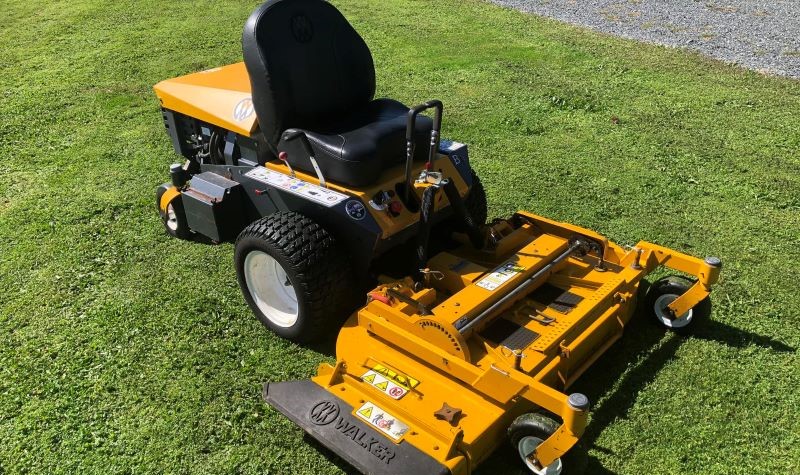
Zero-turn mowers: 64-80 oz of oil
Zero-turn mowers are a type of lawn mower that requires a larger amount of oil compared to other models. They typically need between 64 and 80 ounces of oil to function properly. It is important to use the correct amount of oil to ensure that the engine is properly lubricated and protected from wear and tear.
Regularly checking and maintaining the oil level in your zero-turn mower will help keep it running smoothly and extend its lifespan
Choosing the Right Oil for Your Lawn Mower
Your first place to go when choosing the right oil for your machine should of course always be the manual. However, if you live in a location with extreme climates then you may want to consider seeking some advice locally as the manual can only give general advice.
My go-to spot for advice on oil is always Briggs and Stratton, they have been around longer than most, you can read more here. What type and how much oil for my lawn mower?
Factors to consider: climate, engine type, oil viscosity
The three main factors that will factor into your choice are climate, and the type of engine you have on your machine and both will have an influence on the thickness (viscosity) of the oil that you will use in your mower.
- Climate: Different climates have different temperature ranges, which can affect how well your mower’s engine functions. For hotter climates, you may want to use a lighter-weight oil, such as SAE 30 or 10W-30. In colder climates, a heavier-weight oil like 5W-30 or 0W-30 may be more suitable.
- Engine Type: The type of engine your lawn mower has will also determine the best oil to use. Most small engines in lawnmowers are four-stroke engines, which require a specific type of oil. It is important to check the owner’s manual or consult with the manufacturer to determine the correct oil type for your specific engine.
- Oil Viscosity: The viscosity of oil refers to its thickness or resistance to flow. It is typically indicated by numbers on the bottle label, such as 10W-30 or SAE 30. Higher viscosity oils are thicker and better suited for higher temperatures, while lower viscosity oils are thinner and better suited for colder temperatures.
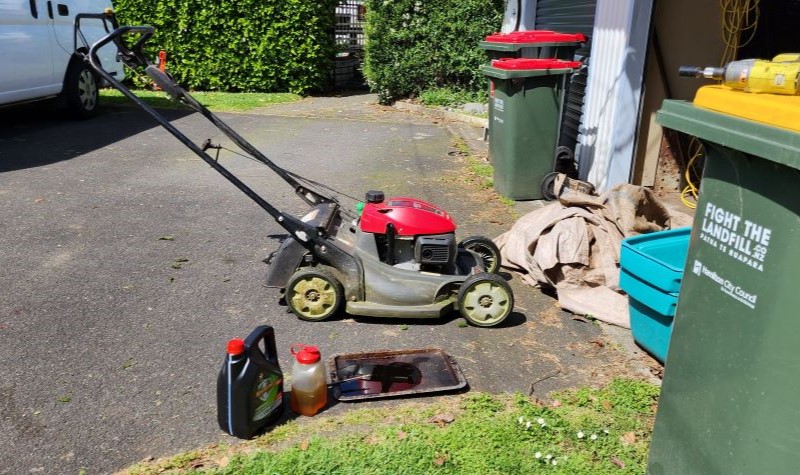
Recommended oil types for common lawn mower brands
I’ve done some research on the recommended oil types for common lawn mower brands. Here are the facts:
- For Briggs and Stratton lawn mowers, it is recommended to use SAE 30 single-weight detergent motor oil that is service-rated SG or higher.
- Honda walk-behind mowers typically require 0.58 US quarts or 0.55 liters of oil, and it is important to use the correct type specified by Honda.
- Snapper mowers also recommend using SAE 30 motor oil, but it’s always a good idea to check the owner’s manual for your specific model.
- Different lawn mower brands may have different oil requirements, so it’s important to consult the owner’s manual or contact the manufacturer to ensure you’re using the right oil type.
Listen to audiobooks while you work.

With a sixty-day free trial
Discover millions of ebooks, audiobooks, and so much more for just $9.99/month.
How to Check The Lawn Mower Oil
The best way to check your oil leave when the engine is cold. Then locate the dipstick. Remove the dipstick and clean the old oil off it. Then insert the dipstick back into the holder without screwing it in, now pull it out and check where the oil level is. There are two markers on the dipstick a low and a high level. Check that the engine has enough oil, If it is below the fill mark then it is time to top it up. Make sure that you to it up to the proper level and do not overfill it.
Changing the oil.
This is how you change the oil. If you prefer videos then this one will walk you through the process.
- Remove the spark plug wire to prevent accidental starting.
- Place an oil drain pan underneath the engine to catch the old oil.
- Locate the drain plug on the bottom of the engine and unscrew it using a wrench or socket. On my Briggs & Stratton engines, I found that a 1/4 inch wrench without a socket did a perfect job.
- Allow the old oil to drain into the pan completely.
- Once all the old oil has drained out, securely tighten the drain plug back into place.
- Clean any spilt oil around the drain plug and wipe off any debris from the area.
- Find the oil fill tube or cap on top of the engine and remove it.
- Use a funnel to pour in fresh oil of the recommended type and amount for your lawn mower model (refer to your owner’s manual for specifications).
- Make sure not to overfill—check the level with a dipstick if available or by visually inspecting through a sight glass, filling until it reaches the proper level.
- Replace and tighten the oil fill cap or tube securely back onto the engine.
- Wipe off any spilt oil and ensure there are no leaks before starting your mower.
- Make sure that the oil cap is tightly screwed on. There is nothing worse than the cap coming off while the mower is running.
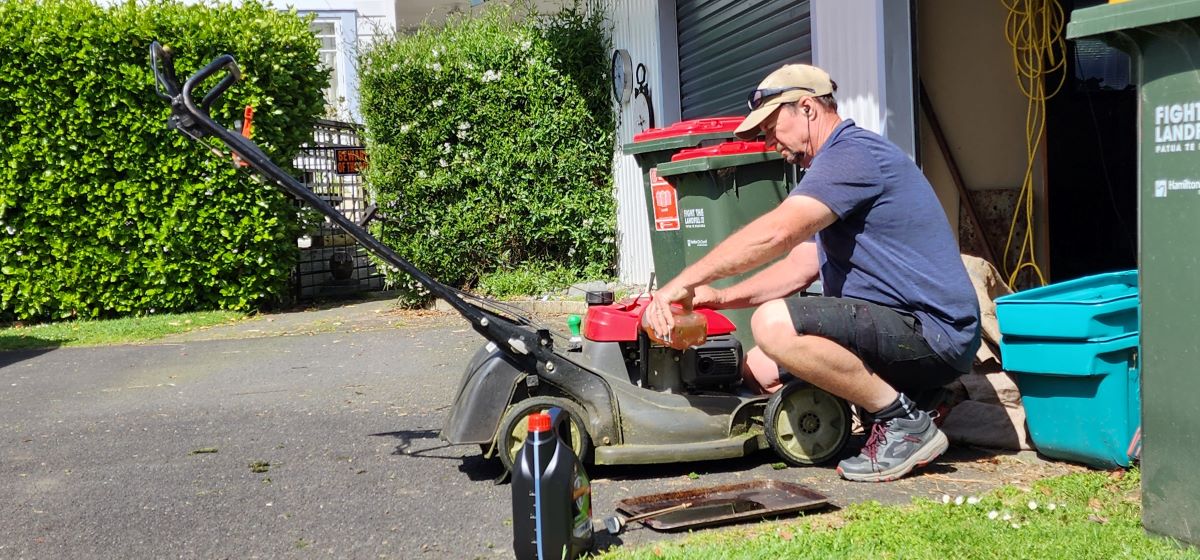
Using other methods that are a bit easier
It can get a bit messy draining the oil from the lawnmower engine however there are a couple of methods that I have used when I just wanted it done quickly.
One of those methods is by using an oil extractor pump. I have one of these in the workshop and it comes in handy. Here are a few of the things I like about an oil extractor pump.
- Not as messy: One of the annoying things about pulling out a sump plug is the moment it comes up, it comes with a fountain of old oil. For a few seconds, it goes everywhere and sometimes you can even drop the plug into the oil tray. This means that you will have to go fishing for it. Not nice at all.
- Easy and convenient: Using an oil pump is a straightforward process. You simply place the pump tube into the engine’s dipstick tube, create suction, and let it do the work for you. It’s a quick and hassle-free way to change the oil in your lawn mower.
- Time-saving: By using an oil pump, you can complete an oil change faster than traditional methods. This is particularly helpful if you have multiple lawnmowers or if you need to change the oil frequently due to heavy use.
Automotive Fluid Extractor Pump

Oil Change Syringe with Hose
Thorstone syringe-style fluid evacuator comes with 1/4″ OD and 3/8″ OD extension tubes
My favourite method
I usually service at least three mowers at one time and I like to get everything done within a couple of hours so I have an even easier method that I use with push mowers.
- Place a drip tray next to the mower on the same side as the oil tank.
- Remove the dipstick and turn the mower over on its side.
- Let the oil drain out and then turn the mower back onto its wheels.
- Put fresh oil in the machine (usually around 20 oz)
- Dispose of the old oil in an environmentally friendly way. ( I save my used oil on a 2.5-gallon container and use the free oil dump and my local dump when it fills up)
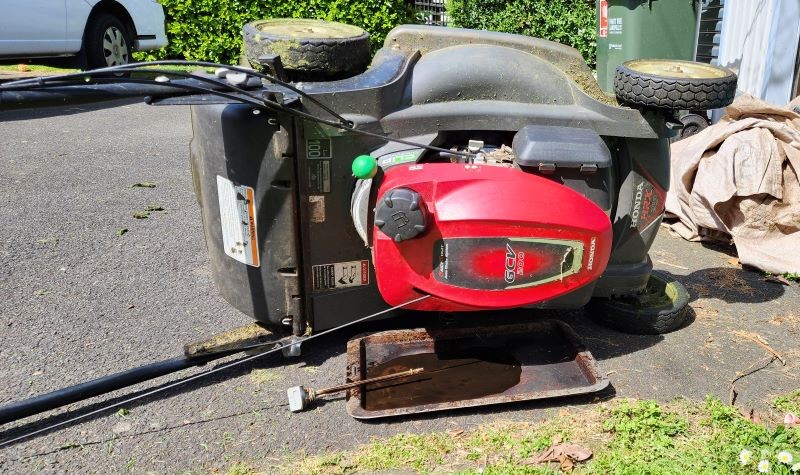
What to do if you overfull your mower.
Dont panic, remember the story at the beginning of this post. Here is what I told him
Simply follow the steps above and tip the excess oil into a container or dip tray.
You may need to replace your air filter if it is paper and soaked with oil. if it is foam then you can wash it with a few drops of dish detergent dry it out and put it back.
Your mower may smoke a bit when you first start it but most of the time it will come right and survive the incident.
Conclusion: Importance of Properly Maintaining Lawn Mower Oil Levels
Properly maintaining the oil levels in your lawn mower is essential for its performance and longevity. By using the right amount and type of oil, and regularly checking and changing it according to the manufacturer’s recommendations, you can ensure that your mower runs smoothly and efficiently.
Taking care of your lawn mower’s oil will help keep it in good working order for years to come.
Get tips & tricks on how to grow a profitable lawn care business delivered to you inbox every week.






Leave a Reply